📅 Updated on: July 2025
📝 Target Exam: JKSSB JE Civil, SSC JE, RRB JE
🔍 Introduction to Fluid Statics
Fluid Statics is the branch of fluid mechanics that deals with fluids at rest. Unlike fluid dynamics (which studies fluids in motion), fluid statics focuses on:
- Distribution of pressure in a fluid
- Forces on submerged surfaces
- Buoyancy and stability of floating bodies
This knowledge is fundamental in the design of:
- Hydraulic structures (dams, weirs)
- Storage systems (tanks, reservoirs)
- Hydraulic instruments (piezometers, manometers)
- Marine structures (ships, pontoons)
For JKSSB Civil aspirants, understanding fluid statics helps answer both theoretical and numerical questions confidently. It also lays the foundation for advanced topics like fluid kinematics, dynamics, and hydraulics.
📘 Basic Properties of Fluids at Rest
- No Shear Stress: In a fluid at rest, there are no shear stresses. This is because the fluid does not resist tangential or shearing forces when it is stationary; it only resists compression through normal stresses. The only stress present in a static fluid is the normal stress, which manifests as pressure. This pressure acts equally in all directions at a point and is responsible for the force exerted by the fluid on the boundaries of its container or submerged bodies. The absence of shear stress is a fundamental characteristic distinguishing fluids from solids in static conditions.
- Pressure Acts Perpendicularly: Pressure always acts perpendicular to the surface it contacts. This is due to the nature of fluid molecules exerting force uniformly in all directions. Regardless of the orientation of the surface—horizontal, vertical, or inclined—the fluid pressure will exert a normal force. This principle is essential in calculating hydrostatic forces on dam walls, gates, and submerged surfaces, where the angle of application of pressure determines structural design. The perpendicular action of pressure also explains the uniform stress distribution on the walls of a container holding a static fluid.
- Incompressibility Assumption: Most civil engineering fluids (e.g., water) are assumed to be incompressible, which simplifies pressure calculations.
📌 Pressure in Fluids
✅ Definition of Pressure
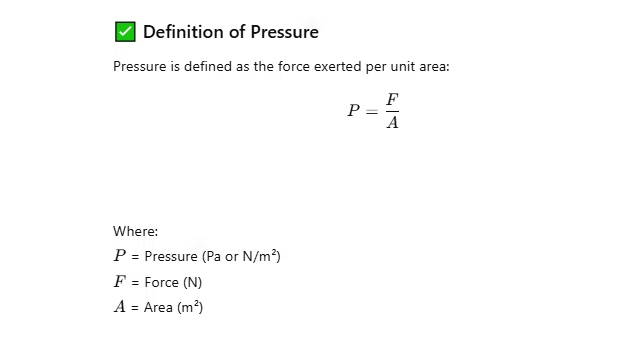
✅ Hydrostatic Pressure
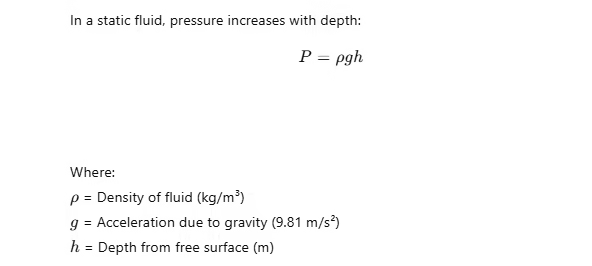
👉 This equation assumes the fluid is incompressible and at rest. It is applicable to open containers, tanks, and natural water bodies.
Illustration: A tank filled with water shows increasing pressure as we move deeper.
✅ Pascal’s Law
“The pressure applied to a confined fluid is transmitted undiminished in all directions throughout the fluid. This means that when an external force is applied to an enclosed fluid (such as in a hydraulic system), the pressure created by this force spreads equally in all directions within the fluid medium. The magnitude of pressure remains the same regardless of the shape of the container or the direction considered. This fundamental principle is used in designing systems like hydraulic lifts, car braking systems, and press machinery.”
Applications:
- Hydraulic press
- Car lifts
- Brake systems
This principle ensures uniform pressure distribution inside confined containers or pipes.
🔎 Types of Pressure

🛠️ Pressure Measuring Instruments
📍 Piezometer
- Simple vertical tube open to the atmosphere.
- Measures pressure head in liquids.
- Cannot measure negative or gas pressures.
📍 U-tube Manometer
- Measures pressure difference using columns of fluid.
- Suitable for small and moderate pressures.
📍 Differential Manometer
- Measures pressure difference between two points in a system.
- Commonly used in flow pipelines.
📍 Barometer
- Measures atmospheric pressure using mercury column.
- Invented by Torricelli.
📍 Inclined Manometer
- Higher accuracy for small pressure changes.
- Fluid column is inclined to increase sensitivity.
🧮 Total Pressure and Centre of Pressure
✅ Total Pressure on Submerged Plane Surface
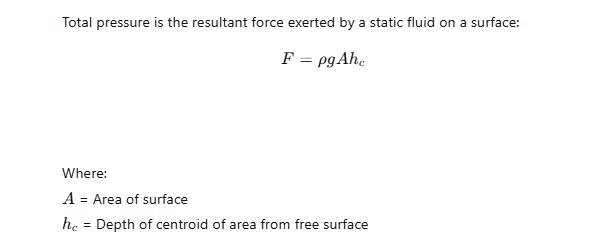
✅ Centre of Pressure
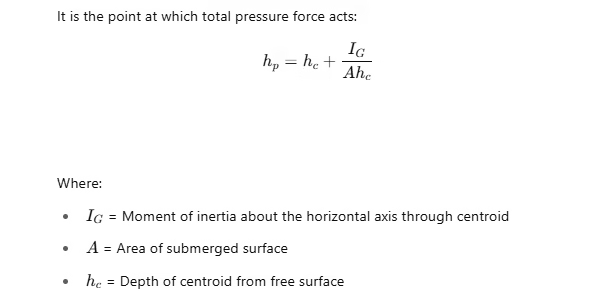
Explanation: The center of pressure is always below the centroid due to increasing pressure with depth.
🌊 Buoyancy and Floatation
✅ Archimedes’ Principle
“A body immersed in a fluid is buoyed up by a force equal to the weight of fluid it displaces. This phenomenon, known as Archimedes’ Principle, explains why some objects float while others sink. When an object is placed in a fluid, it pushes the fluid aside, or displaces it. The fluid, in response, exerts an upward force (buoyant force) equal to the weight of the displaced fluid. If this upward force is greater than or equal to the weight of the object, the object floats. Otherwise, it sinks. This principle is used extensively in shipbuilding, designing floating platforms, and determining the density of unknown objects.”
Buoyant Force:
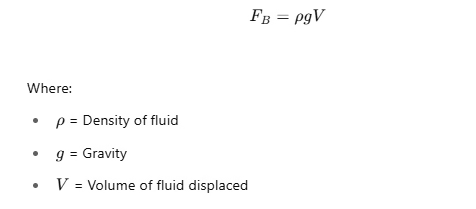
✅ Conditions for Floatation
| Case | Condition |
|---|---|
| Body floats | Weight = Buoyant Force |
| Body sinks | Weight > Buoyant Force |
| Body rises | Weight < Buoyant Force |
⚓ Stability of Floating Bodies
✅ Metacentre (M) and Centre of Gravity (G)
The point at which the line of action of buoyant force intersects the centerline of a floating body when the body is slightly tilted is called the metacentre (M). It is a crucial point in determining the stability of floating bodies such as ships or pontoons. If the metacentre lies above the center of gravity (G) of the body, the body is said to be in stable equilibrium. If the metacentre lies below the center of gravity, the equilibrium is unstable. The vertical distance between the center of gravity (G) and the metacentre (M) is known as the metacentric height (GM), which serves as an indicator of the stability of the floating object.
✅ Metacentric Height (GM)
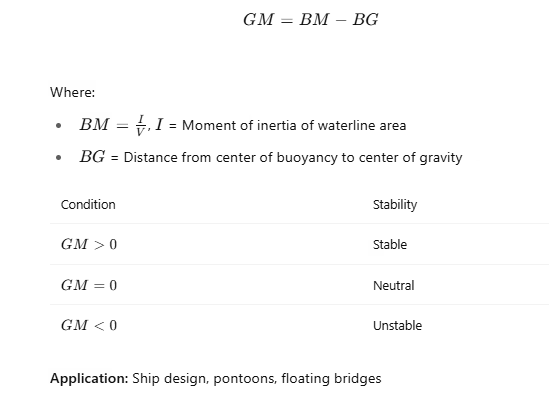
📑 Summary Table of Key Formulas
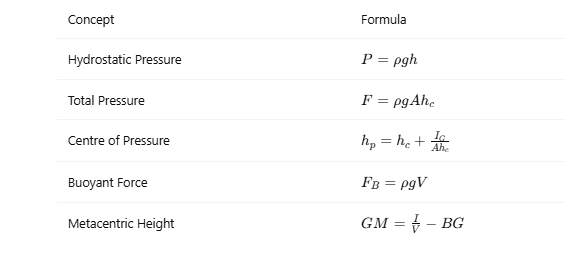
🎯 Importance of Fluid Statics for JKSSB Aspirants
- High-weightage topic in JKSSB JE Civil and SSC JE exams.
- Frequently asked questions on:
- Manometers
- Pressure calculations
- Archimedes’ principle
- Centre of pressure derivations
- Helps in real-world applications like tank design, canal hydraulics, and floating structures.
📝 Expert Preparation Tips
- Create flashcards for all formulas
- Practice derivations of center of pressure and buoyancy
- Solve numerical problems using manometers and barometers
- Focus on concept visualization (use drawings and animations)
- Attempt JKSSB PYQs and mock tests
🧾 Conclusion: Importance of Fluid Statics in Civil Engineering
Fluid Statics forms the foundational basis of fluid mechanics and is crucial for civil engineers, especially in areas such as hydraulic structures, water tanks, retaining walls, dams, pressure conduits, and fluid measurement devices. The principles learned—such as hydrostatic pressure, buoyancy, Pascal’s law, and the concept of the metacentre—equip engineers with the tools to analyze and design safe and efficient structures that interact with fluids.
Understanding the behavior of fluids at rest enables civil engineers to:
- Calculate and safely distribute forces on submerged surfaces (e.g., dam faces, sluice gates).
- Ensure stability of floating bodies (e.g., pontoons, ships).
- Design precise pressure measurement systems (e.g., piezometers, manometers).
- Use hydraulic systems effectively by applying Pascal’s Law.
- Ensure structural safety by predicting how fluids will exert pressure on various geometries.
For JKSSB Civil Engineering aspirants, mastering fluid statics is not just about clearing exams—it’s about building core conceptual clarity for both academic and practical success. Many competitive exams include direct and numerical questions from this topic. A strong grasp of this subject enhances your ability to tackle advanced topics like fluid dynamics, hydraulic machinery, and open channel flow.
✅ Pro Tip for Preparation: Practice numerical problems related to hydrostatic pressure, center of pressure, and buoyancy. Memorize key formulas in Unicode characters as per JKSSB format, and revise concepts like Pascal’s law and metacentric height frequently.
📌 Join our Telegram Channel JKSSB CivilsCentral for regular updates, quizzes, PDF notes, and practice sets curated specifically for JKSSB aspirants.


